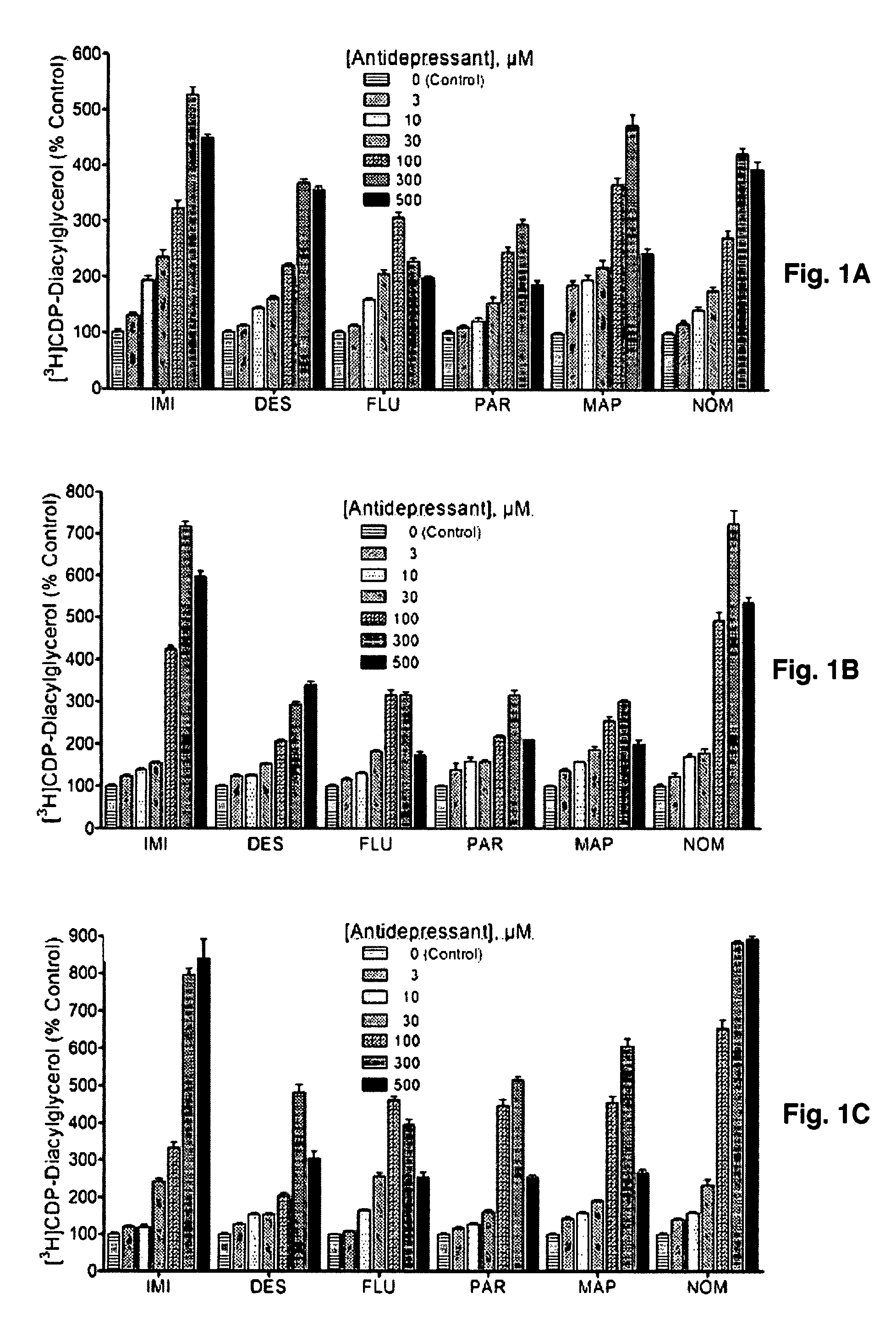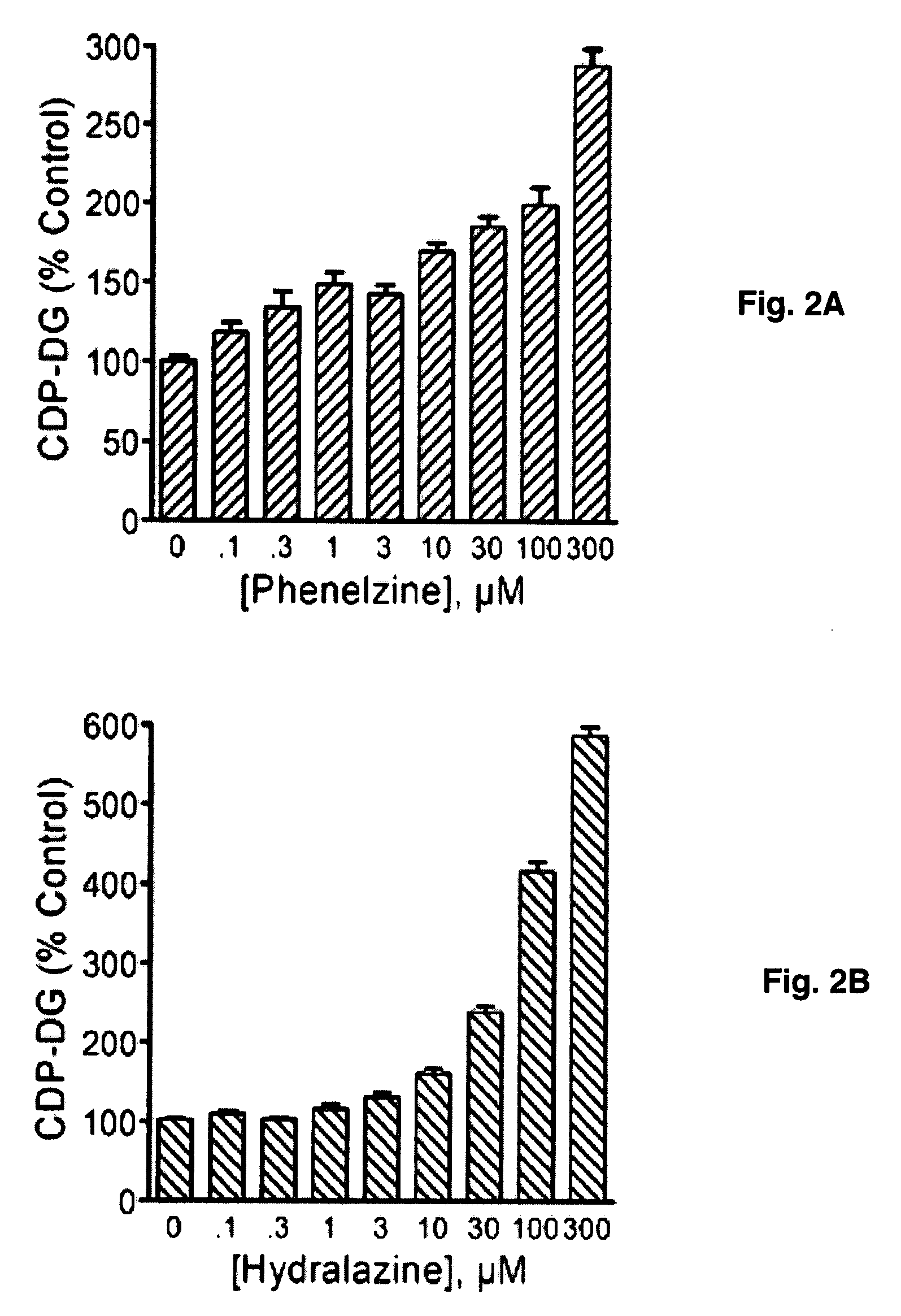Manipulation of brain CDP-diacylglycerol and uses thereof
a technology of diacylglycerol and brain, applied in the field of psychopharmacology, can solve the problems of hampered efforts to develop safer and more effective medications, and have not assessed the status of diacylglycerol production or metabolism as a potential target, and achieve the effect of reducing the symptoms of depression
- Summary
- Abstract
- Description
- Claims
- Application Information
AI Technical Summary
Benefits of technology
Problems solved by technology
Method used
Image
Examples
example 1
Animals
[0084]Male Sprague-Dawley rats, weighing between 225 g-300 g, were obtained from Zivic Laboratories (Zelienople, Pa.) and housed in climate-controlled facilities with a 12-h light / dark cycle for at least 3 days before use. The animals were caged in groups of three and allowed free access to food and water.
Drugs and Chemicals
[0085]Antidepressant compounds and buffer reagents were purchased from Sigma-Aldrich (St. Louis, Mo.). SKF38393 was from the NIMH Chemical Synthesis Program (NIMH, Bethesda, US). Nomifensine was first dissolved in 0.2% tartaric acid and SKF38393 in distilled water before either drug was diluted to use concentrations in assay buffer. Other drugs were prepared fresh in HEPES bicarbonate assay buffer (HBB) (57). Each experiment was performed on multiple occasions using fresh preparations of drugs. Protein was assayed by the Bradford method using BioRad protein assay reagents (BioRad, Hercules, Calif.).
Measurement of CDP-Diacylylycerol Accumulation
[0086]Accumu...
example 2
Chemically Diverse Antidepressant Agents Increase CDP-Diacylglycerol Production
[0094]Diacylglycerol released from phospholipid breakdown is normally rapidly phosphorylated to produce phosphatidic acid. In the presence of [3H]cytidine-labeled CTP, however, the phosphatidic acid is converted to radiolabeled CDP-DG, which can be extracted and separated away from other labeled metabolites and subsequently quantified. Rat brain cerebrocortical, hippocampal, and striatal slices prelabeled with [3H]cytidine were incubated with various concentrations of selected antidepressant agents in the presence of LiCl, and the yield of CDP-diacylglycerol analyzed. Data for each drug were separately analyzed before they were normalized and collated together for graphical presentation as shown.
[0095]The classical antidepressants imipramine and desipramine, the selective serotonin reuptake inhibitors fluoxetine and paroxetine and the atypical agents maprotiline and nomifensine each significantly and dose...
example 3
Antidepressant-Induced CDP-Diacylglycerol Formation Translates into Increased Phosphoinositide Synthesis
[0099]To test if the antidepressant-enhanced CDP-DG translates into increased synthesis of the PIs, brain slice preparations were labeled with [3H] inositol and incubated in the presence of various antidepressant agents. Results of the subsequent uptake and conversion of [3H] inositol into inositol phospholipids are shown in FIGS. 3A-3C. Imipramine, desipramine, fluoxetine, paroxetine, and maprotiline each significantly increased [3H]inositol labeling of PIs in the tested brain regions. MAOIs that were effective in inducing CDP-DG production also showed enhanced effects on PI resynthesis (FIGS. 4A-4B), whereas other MAOIs that were ineffective on CDP-DG were equally ineffective in increasing PI resynthesis. Thus, the increased mobilization or recapture of CDP-DG by the antidepressant agents translates into increased regeneration of PI signaling substrates.
PUM
| Property | Measurement | Unit |
|---|---|---|
| time | aaaaa | aaaaa |
| time | aaaaa | aaaaa |
| time | aaaaa | aaaaa |
Abstract
Description
Claims
Application Information
 Login to View More
Login to View More - R&D
- Intellectual Property
- Life Sciences
- Materials
- Tech Scout
- Unparalleled Data Quality
- Higher Quality Content
- 60% Fewer Hallucinations
Browse by: Latest US Patents, China's latest patents, Technical Efficacy Thesaurus, Application Domain, Technology Topic, Popular Technical Reports.
© 2025 PatSnap. All rights reserved.Legal|Privacy policy|Modern Slavery Act Transparency Statement|Sitemap|About US| Contact US: help@patsnap.com



